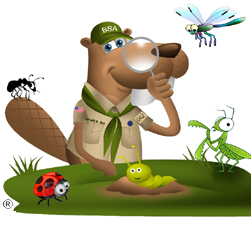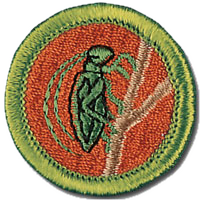Insect Study


Resources
- Insect Study Merit Badge Pamphlet
- Insect Study Merit Badge Workbook
- Scoutmaster Bucky's Merit Badge Advancement Quick Reference
- Scoutmaster Bucky's Acknowledgement Form
Related
Insect Study Requirements
Current Scouts BSA requirements
as of December 16, 2025
as of December 16, 2025
1.
Safety. Do the following:
a.
Explain to your counselor the most likely hazards associated with
exposure to ants and bees and what you should do to anticipate, help
prevent, mitigate, and respond to these hazards.
b.
Discuss the prevention of and treatment for health concerns that could
occur while working with ants and bees, including insect bites and
anaphylactic shock.
2.
Anatomy. Do the following:
a.
Tell how insects are different from other animals.
b.
Show how insects are different from millipedes and spiders.
c.
Point out and name the main parts of an insect.
d.
Describe the characteristics that distinguish the major orders of
insects.
3.
Life Cycles. Do the following:
a.
Compare the life histories of a butterfly and a grasshopper. Tell how
they are different.
b.
Raise an insect through complete metamorphosis from its larval stage
to its adult stage (e.g., raise a butterfly or moth from a caterpillar).
(Some insects are endangered species and are protected by federal or
state law. Every species is found only in its own special type of
habitat. Be sure to check natural resources authorities in advance to be
sure that you will not be collecting any species that is known to be
protected or endangered, or in any habitat where collecting is
prohibited. In most cases, all specimens should be returned at the
location of capture after the requirement has been met. Check with your
counselor for those instances where the return of these specimens would
not be appropriate.)
4.
Observation and Analysis. Do the following:
a.
Discuss the importance of the Leave No Trace Seven Principles and the
Outdoor Code as they relate to insect study. Explain how you have
followed the Leave No Trace Seven Principles and the Outdoor Code
during field observation, specimen collection, and identification.
b.
Observe 20 different live species of insects in their habitat. In your
observations, include at least four orders of insects.
c.
Make a scrapbook of the 20 insects you observe in 5(b) Include
photographs, sketches, illustrations, and articles. Label each insect
with its common and scientific names, where possible. Share your
scrapbook with your counselor.
d.
From your scrapbook collection, select eight species of insects and
identify what role they play in the ecosystem.
5.
Social Insects. Do the following:
a.
Tell things that make social insects different from solitary
insects.
b.
Do ONE of the following:
1.
Observe an ant colony in a formicarium (ant farm). Find the queen
and worker ants. Explain to your counselor the different chambers
found within an ant colony.
2.
Study a hive of bees. Remove the combs and find the queen. Estimate
the amount of brood and count the number of queen cells. Explain
how to determine the amount of honey in the hive. (If you are
allergic to bee stings, pick option 1 above.)
6.
Ecology. Do the following:
a.
Tell how insects fit in the food web of other insects, fish, birds, and
mammals.
b.
Explain the role insects serve as pollinators for plants.
7.
Insects and People. Do the following:
a.
Explain the symbiotic relationship between bees and humankind. Explain
what colony collapse disorder (CCD) is and some of the possible causes.
Discuss how CCD affects our food supply.
b.
Describe three alternatives to insecticides as a way of preventing crop
injury and subsequent yield loss. Explain the advantages and
disadvantages of these alternatives.
8.
Conservation. Do the following:
a.
Tell the migration route of an insect (e.g., monarch butterfly).
Discuss the challenges they face and how Scouts can contribute to
their success.
b.
Find out about an insect that is a threatened or endangered
species. Discuss the challenges they face and how Scouts can
contribute to their success.
9.
Careers and Hobbies. Do ONE of the following:
a.
Identify three career opportunities that would use skills and knowledge
in Insect Study. Pick one and research the training, education,
certification requirements, experience, and expenses associated with
entering the field. Research the prospects for employment, starting
salary, advancement opportunities and career goals associated with this
career. Discuss what you learned with your counselor and whether you
might be interested in this career.
b.
Identify how you might use the skills and knowledge in Insect Study to
pursue a personal hobby. Research the additional training required,
expenses, and affiliation with organizations that would help you
maximize the enjoyment and benefit you might gain from it. Discuss what
you learned with your counselor and share what short-term and long-term
goals you might have if you pursued this.